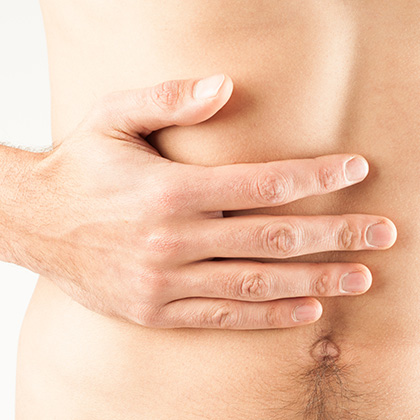In the 1970s, doctors in America identified a condition they called candidiasis. More commonly known as candida, it’s thought to affect a growing number of people – especially women, who are more likely to suffer than men (young women, for instance, are believed to be those most likely to suffer from candida infection in its most common form: thrush).
Candida is caused by an overgrowth of the yeast Candida albicans (C. albicans), which is found naturally in low levels in the body along with many other micro-organisms. Moderate amounts of this yeast live in all of us, usually without causing any harm. But certain circumstances are thought to allow the yeast to grow unchecked by the immune system, the result of which is a candida infection.
Candida can affect different areas of the body including the skin, genitals, throat and mouth:
-
A candida infection of the mouth or throat is usually referred to as oral thrush, oral candidiasis or oropharyngeal candidiasis. Oral thrush is common in babies (experts believe about one in seven babies develop it at some point (i)) as well as older people, plus people who have diabetes, an underactive thyroid, HIV or an iron or vitamin B12 deficiency.
-
Candida of the genitals is most commonly called a yeast infection or thrush. Vaginal thrush is very common and is thought to affect three out of four women at some point in their lives (ii). Men too can be affected by genital thrush.
-
Candida can also affect the skin, causing nappy rash in babies, for instance.
All of these conditions are recognised by the medical profession and are treatable with conventional medicines. But an overgrowth of candida within the intestines – sometimes called candida overgrowth syndrome (COS) or simply yeast syndrome – is a much more controversial issue, with many conventional health experts dismissing it as a fad. That’s because the evidence to support the diagnosis of COS isn’t strong, which may explain why many health practitioners doubt it even exists.
Many natural health practitioners and nutritionists, on the other hand, believe it’s a growing problem.
What are the symptoms?
Part of the problem may lie in the numerous symptoms associated with COS, many of which are also associated with other hard-to-diagnose conditions. Some of the most common symptoms of COS are believed to include the following:
-
Gastrointestinal symptoms such as diarrhoea, constipation, bloating, abdominal pain and wind
-
Headache, muscle and joint aches
-
Extreme tiredness, poor memory and concentration difficulties
-
Frequent colds, sore throat and sinusitis
-
Recurrent bouts of vaginal thrush
-
Depression and mood swings
-
Food cravings (particularly for sugary foods)
Some practitioners believe COS is responsible for numerous other health conditions too, including everything from athlete’s foot to an irregular heartbeat.
What causes candida?
According to the practitioners who treat people for candida and candida overgrowth syndrome (COS), there are several things that may increase your susceptibility to yeast overgrowth. Some of these things include the following:
-
Prescription medicines
The most commonly cited cause of candida is the overuse of antibiotics. Indeed, people who are thought to have a particularly high risk for developing candida infections and COS are those who have been using broad-spectrum antibiotics in the long term for chronic conditions such as acne and recurring infections. The theory is that because antibiotics kill both beneficial and harmful strains of bacteria in the body, the result is an internal imbalance of both bacteria and other micro-organisms, which provides the conditions for the candida yeast to multiply. Other medicines that are also often linked to the development of candida and COS include oral contraceptives, hormone replacement therapy (HRT), steroid tablets and chemotherapy. Diet: Eating too much sugar is thought to contribute to the development of candida and COS. This idea may be popular because sugar provides the energy yeast needs to grow, and many nutritional practitioners claim eating a diet high in sugar as well as refined carbohydrates such as processed foods made with white flower may lead to a candida problem. -
Diet
Eating too much sugar is thought to contribute to the development of candida and COS. This idea may be popular because sugar provides the energy yeast needs to grow, and many nutritional practitioners claim eating a diet high in sugar as well as refined carbohydrates such as processed foods made with white flour may lead to a candida problem. -
Weakened immune system
People with conditions that affect the immune system such as HIV are also thought to be more susceptible to repeated yeast infections. -
Stress
If you have high stress levels, some experts believe your immune system may be affected, which may in turn lead to candida or COS (iii). -
Hormones
Female hormones associated with the menstrual cycle, pregnancy and menopause may, in some women, upset the body’s bacterial balance, leading to candida in those who are susceptible. This may explain why some women find they develop vaginal thrush at certain times during their cycle, during pregnancy and the menopause, and also while taking oral contraceptives. -
Alcohol
Since yeast and sugar are used to make alcohol, some practitioners also believe drinking too much can lead to candida and COS (iv).
Candida: how diet may help
Since diet seems to play a part in encouraging candida and COS, avoiding certain foods and eating more of others is thought to help manage or even eliminate a yeast problem.
-
Sugar
Many nutritional practitioners recommend a diet that’s low in all forms of sugar, including sucrose, honey, glucose, fructose, dextrose and even sweeteners such as aspartame, saccharine and sucralose. You may also be advised to avoid eating foods that are high in sugar such as most fruit, grains that contain gluten (wheat, oats, rye and barley) and certain vegetables such as sweet potatoes, carrots and parsnips during the first few weeks of an anti-candida diet. As alcohol contains a high level of sugar, you may be advised to stop drinking it – at least for a while – too. -
Yeast
Similarly, experts recommend that foods containing yeast – including bread yeast extract spreads and even some gravy mixes – should be limited. And since yeast is a fungus, other foods you may need to limit include mushrooms and truffles. Eating garlic, on the other hand, may help to manage yeast overgrowth as it’s thought to have anti-fungal properties. -
Live yoghurt
Eating yoghurt that contains active or live cultures of bacteria such as acidophilus and bifobacterium may help restore the balance of your internal bacteria and thereby discourage the growth of candida. Some nutritional practitioners, however, believe you should avoid dairy products for the first few weeks, as they contain a naturally occurring sugar called lactose. -
Veggies
While you may need to cut out vegetables with a high sugar content, other varieties may help encourage the growth of beneficial bacteria in your body. Vegetables that contain an insoluble fibre called inulin – such as Jerusalem artichokes, asparagus, leeks, onions and bananas – are one example. Eating more beans and other pulses may also help regulate your body’s bacterial balance.
Meanwhile, health professionals who are sceptical about COS and the idea that diet may help believe simply avoiding sugar and white flour could relieve a variety symptoms and make you feel better in general. Whether or not diet can prevent the growth of candida in the gastrointestinal system is, therefore, still up for debate.
Self-help tips for candida
If you think you may have an overgrowth of candida, there are some things you can do that may help, including the following: Try to avoid taking antibiotics unless absolutely necessary. This isn’t just a good idea as a strategy to reduce candida overgrowth, but may help with the threat of antibiotic resistance too. Antibiotic resistance is a considerable concern right now, as health experts fear that overusing antibiotics means the bacteria they are designed to kill will become resistant to them. This could mean that bacterial infections – including life-threatening ones – may not respond to antibiotics in the future.
Some practitioners who treat people with suspected candida overgrowth syndrome (COS) believe that antibiotics overuse may be the most common cause, and suggest taking antibiotics only when they are really needed (that is, they should be avoided for mild infections). Since broad-spectrum antibiotics are arguably the most likely culprit, they also recommend asking your GP for narrow-spectrum antibiotics whenever possible, as these only target a specific bacterium rather than all bacteria, good and bad.
Make changes to your lifestyle that could help boost your immune system. The following may be worth a try:
-
Take regular exercise
-
Get more sleep
-
Take more time off (have a holiday)
-
Relax: try yoga, t’ai chi or meditation
Avoid perfumed bath or feminine products if you suffer from recurrent vaginal thrush. The chemicals in the perfume can irritate the vaginal membranes, so it may be advisable to stop using these types of products. If you feel you must add something to your bath, choose a few drops of lavender or tea tree oil instead of commercial bubble bath products. Wearing cotton or silk underwear instead of that made from synthetic fabrics may also help prevent vaginal thrush.
Drink plenty of water, which some experts believe helps to flush waste and toxins out of the body.
Natural remedies for candida
As well as the things you can do for yourself in terms of your lifestyle, there are a few natural remedies you could try to get a candida problem under control:
Live bacteria
Taking products containing live bacteria such as L acidophilus, L casei, S boulardii and B bifidus may counteract the growth of candida and keep it at a reasonable level. Indeed, at least one study suggests that acidophilus may prevent recurrence of candida (v) while a review of studies on the effectiveness of live bacteria in candida colonisation suggests live bacteria may help combat chronic mucosal candida infections (vi). These beneficial live bacteria are widely available in powder, liquid, capsule or tablet form, as well as in certain dairy-based food products.
Cinnamon
Researchers have discovered that cinnamon has anti-fungal properties, which suggests it may be a useful natural remedy for candida. One small-scale study has found that after taking a supplement that included cinnamon oil, 72 percent of patients infected with intestinal candida were candida free after just 14 days (vii). Meanwhile researchers writing in the Journal of Clinical & Diagnostic Research found that cinnamon oil may be effective against some candida species that are becoming increasingly resistant to conventional anti-fungal medicines, including C. albicans (viii).
Oregano
This common culinary herb was originally used in ancient Greece to treat wounds, snake bites, spider bites and respiratory problems. These days oregano is often used – sometimes in its essential oil format – by natural practitioners to treat candida thanks to the way it can kill many types of micro-organisms, including fungi (ix). Researchers have also carried out in vitro tests, discovering that oregano essential oil has sufficient antifungal activity against species of candida to suggest its use as an alternative treatment for candidiasis (x).
Olive leaf
Like oregano, olive leaf has been used traditionally to treat wound infections as well as other diseases, and is now often used as a natural remedy for candida. It too has been found to have anti-microbial properties (xii), and that it may be effective against C albicans (xii).
Garlic
Another plant with anti-fungal properties is garlic. In-vitro studies also suggest it is effective against candida (xiii), while other researchers have found it may be more effective in the treatment of candida than a conventional anti-fungal treatment called nystatin (xiv).
L-Theanine
Some people with candida may also understandably be affected by stress. In such cases it may help to take a supplements that includes ingredients such as the amino acid L-Theanine, which may help reduce stress without causing drowsiness (xv).
High-strength multivitamin and mineral
It may also be a good idea to take a good-quality multivitamin and mineral to help support your immune system when you have the symptoms of an overgrowth of candida. Certain vitamins and minerals, for instance, may be beneficial as they’re thought to help improve immune function, including vitamin D (xvi) and zinc (xvii).
References:
-
Available online: https://patient.info/childrens-health/oral-thrush-in-babies
-
Available online: https://patient.info/sexual-health/vaginal-discharge-female-discharge/vaginal-thrush-yeast-infection
-
Available online: https://www.mindbodygreen.com/0-23910/the-one-thing-to-do-every-day-to-avoid-candida-overgrowth-a-doctor-explains.html
-
Available online: https://www.thecandidadiet.com/alcohol-and-candida/
-
Collins. FB, Hardt. P. Inhibition of Candida albicans by Lactobacillus acidophilus. J Dairy Sci. 1980;63:830-2.
-
Matsubara VH et al., Probiotics as Antifungals in Mucosal Candidiasis. Clinical Infectious Diseases. 2016 May 1;62(9):1143-1153.Available online: https://academic.oup.com/cid/article/62/9/1143/1745140
-
Gang-sheng. W, Jie-hua. D, et al. Mechanisms, clinically curative effects, and antifungal activities of cinnamon oil and pogostemon oil complex against three species of Candida. J Trad Ch Med. 2012 Mar;19-24.
-
Goel N et al., Antifungal Activity of Cinnamon Oil and Olive OIl against Candida Spp. Isolated from Blood Stream Infections. J Clin Diagn Res. 2016 Aug;10(8):DC09-DC11.Available online: https://www.ncbi.nlm.nih.gov/pmc/articles/PMC5028442/
-
Sokovic. M, Tzakou. O, Sokovic. D, Couladis. M. Antifungal activities of selected aromatic plants growing wild in Greece. Nahrung. 2002;46:317-20.
-
Hammer. KA, Carson. CF, Riley. TV, Couladis. M. In-vitro activity of essential oils, in particular Melaleuca alternafolia (tea tree) oil and tea tree oil products, against Candida albicans. J Antimicrobial Chemother. 1998;42:591-5.
-
Cleff MB et al., In vitro activity of origanum vulgare essential oil against candida species. Braz J Microbiol. 2010 Jan-Mar;41(1):116-123.Available online: https://www.ncbi.nlm.nih.gov/pmc/articles/PMC3768597/
-
Korukluoglu. MS, Sahan. Y, et al. Antifungal activity of olive leaf (Olea Europea L) extracts from the Trilye Region of Turkey. Annals of Microbiology. 12/2006; 56(4):359-362.
-
Nasrollahi. Z., Abolhasannezhad M., Evaluation of the antifungal activity of olive leaf aqueous extracts against Candida Albicans PTCC-5027. Curr Med Mycol. 2015 Dec;1(4):37-39. Available online: https://www.ncbi.nlm.nih.gov/pmc/articles/PMC5490280/
-
Sandhu. DK, Warraich. MK, Singh. S. Sensitivity of yeasts isolated from cases of vaginitis to aqueous extracts of garlic. Mykosen. 1980;23:691-8.
-
Shams-Ghahforoki M et al., In vitro antifungal activities of Allium cepa, Allium sativum and ketoconazole against pathogenic yeasts and dermatophytes. Fitotherapia. 2006 Jun;77(4):321-3.Available online: https://www.ncbi.nlm.nih.gov/pubmed/16690223
-
Arora. DS, Kaur. J. Anti-microbial activity of spices. Int J Antimicrob Agents. 1999;12:257-62.
-
Juneja. LR. Suntheanine and its relaxation effect in humans. Trends in Food Science & Tech. 1999;10;199-204.
-
Kimura. K, Ozeki. M, Juneja. LR, Ohira. H. L-Theanine reduces psychological and physiological stress responses. Biol Psychol. 2007;74(1):39-45.
-
White DJ et al., . Anti-Stress, Behavioural and Magnetoencephalography Effects of an L-Theanine-Based Nutrient Drink: A Randomised, Double-Blind, Placebo-Controlled, Crossover Trial. Nutrients. 2016 Jan;8(1):53.Available online: https://www.ncbi.nlm.nih.gov/pmc/articles/PMC4728665/
-
Aranow. C. Vitamin D and the Immune System. J Investig Med. 2011 Aug;59(6):881-886.
-
Saul L et al., 1,25-Dihydroxyvitamin D3 Restrains CD4 T Cell Priming Ability of CD11c Dendritic Cells by Upregulating Expression of CD31. Frontiers in Immunology. 2019;10.Available online: https://www.frontiersin.org/articles/10.3389/fimmu.2019.00600/full
-
Chandra. RK. Trace element regulation of immunity and infection. J Am Coll Nutr. 1985;4:5-16.
-
Fraker. PJ, Gershwin. ME, Good. RA, et al. Interrelationships between zinc and immune function. Fed Proc. 1986;45:1474-1479.
-
Gammoh. RK., Rink L., Zinc in Infection and Inflammation. Nutrients. 2017 Jun 1;9(6):624. Available online: https://www.ncbi.nlm.nih.gov/pmc/articles/PMC5490603/
Related Posts
Disclaimer: The information presented by Nature's Best is for informational purposes only. It is based on scientific studies (human, animal, or in vitro), clinical experience, or traditional usage as cited in each article. The results reported may not necessarily occur in all individuals. Self-treatment is not recommended for life-threatening conditions that require medical treatment under a doctor's care. For many of the conditions discussed, treatment with prescription or over the counter medication is also available. Consult your doctor, practitioner, and/or pharmacist for any health problem and before using any supplements or before making any changes in prescribed medications.

Christine
Christine Morgan has been a freelance health and wellbeing journalist for almost 20 years, having written for numerous publications including the Daily Mirror, S Magazine, Top Sante, Healthy, Woman & Home, Zest, Allergy, Healthy Times and Pregnancy & Birth; she has also edited several titles such as Women’ Health, Shine’s Real Health & Beauty and All About Health.
View More



